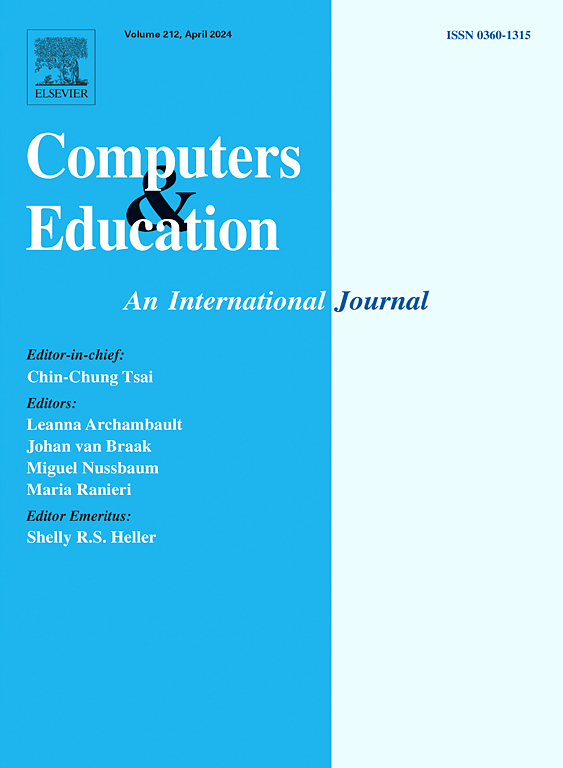Tailoring educational support with graph neural networks and explainable AI: Insights into online learners' metacognitive abilities
IF 10.5
1区 教育学
Q1 COMPUTER SCIENCE, INTERDISCIPLINARY APPLICATIONS
引用次数: 0
Abstract
Metacognition—the awareness and regulation of one's thinking processes—plays a crucial role in self-regulated learning (SRL), yet traditional educational research methods struggle to capture how metacognitive abilities manifest in actual learning behaviors. While computer-assisted learning (CAL) environments offer rich opportunities to observe these processes in action, educational researchers have typically analyzed this data using approaches that fail to connect metacognitive abilities with the complex, sequential nature of SRL behaviors. Our study bridges this gap by examining how 49 university students' metacognitive abilities shaped their learning patterns over one semester. We introduced a novel methodological approach that transforms diverse digital traces into unified graph structures, allowing us to map connections between metacognitive abilities and the planning, monitoring, and evaluation phases of SRL. Using attributed graphs, we integrated both static indicators and sequential behavioral patterns to predict metacognitive abilities with significantly higher accuracy than traditional single-data approaches, including Long Short-Term Memory (LSTM), Recurrent Neural Networks (RNN), Artificial Neural Networks (ANN), and Random Forest (RF). Through Explainable AI techniques, we revealed that high-metacognitive learners exhibited comprehension-centered, goal-oriented strategies across learning phases, while low-metacognitive learners focused primarily on task completion with limited strategic planning. These insights enabled us to develop personalized metacognitive profiles that can guide targeted educational interventions. Our approach demonstrates how advanced analytical methods can transform educational data into meaningful insights about cognitive processes, offering educators new ways to understand and support students' metacognitive development.

用图形神经网络和可解释的人工智能定制教育支持:对在线学习者元认知能力的洞察
元认知是对一个人的思维过程的意识和调节,在自我调节学习(SRL)中起着至关重要的作用,然而传统的教育研究方法很难捕捉到元认知能力如何在实际学习行为中表现出来。虽然计算机辅助学习(CAL)环境为观察这些过程提供了丰富的机会,但教育研究人员通常使用的方法无法将元认知能力与SRL行为的复杂、顺序性联系起来。我们的研究通过考察49名大学生的元认知能力如何在一个学期内塑造他们的学习模式来弥补这一差距。我们介绍了一种新的方法,将不同的数字痕迹转换为统一的图形结构,使我们能够映射元认知能力与SRL的计划、监测和评估阶段之间的联系。利用属性图,我们整合了静态指标和顺序行为模式来预测元认知能力,其准确性明显高于传统的单数据方法,包括长短期记忆(LSTM)、循环神经网络(RNN)、人工神经网络(ANN)和随机森林(RF)。通过可解释的人工智能技术,我们发现高元认知学习者在学习阶段表现出以理解为中心、以目标为导向的策略,而低元认知学习者主要关注任务完成,策略规划有限。这些见解使我们能够开发个性化的元认知概况,从而指导有针对性的教育干预。我们的方法展示了先进的分析方法如何将教育数据转化为有关认知过程的有意义的见解,为教育工作者提供了理解和支持学生元认知发展的新方法。
本文章由计算机程序翻译,如有差异,请以英文原文为准。
求助全文
约1分钟内获得全文
求助全文
来源期刊

Computers & Education
工程技术-计算机:跨学科应用
CiteScore
27.10
自引率
5.80%
发文量
204
审稿时长
42 days
期刊介绍:
Computers & Education seeks to advance understanding of how digital technology can improve education by publishing high-quality research that expands both theory and practice. The journal welcomes research papers exploring the pedagogical applications of digital technology, with a focus broad enough to appeal to the wider education community.
 求助内容:
求助内容: 应助结果提醒方式:
应助结果提醒方式:


